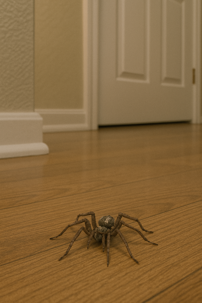Why spiders feel “suddenly everywhere” in late summer and fall
Spiders are present all year, but they’re more visible as days stay warm and nights turn cool. In the Treasure Valley, that weather pattern does two things at once:
- Mating season peaks. Mature male spiders wander away from hidden webs to find females, so you notice them along baseboards, in bathrooms, and around doorways even if populations haven’t actually exploded.
- Prey shifts indoors. Ants, flies, and other insects track warmth and light around houses; spiders follow their food into garages, basements, and utility rooms. (They’re not seeking people—they’re seeking prey and shelter.)
Field checklist: where we actually find them on service calls
- Garages/sheds & crawl spaces: quiet, dark, and cluttered = prime black widow habitat; look near shelving, stacked boxes, meter boxes, and door tracks.
- Basements & window wells: funnel-weaving spiders (often called hobo/funnel weavers) and common house spiders build sheet/funnel webs along sill plates and vents.
- Eaves/porches/outdoor lights: orb weavers set large night webs where flying insects congregate.
- Living spaces (late summer–fall): wandering males of several species show up indoors; this is seasonal behavior, not necessarily an “infestation.”
Light-smart home tips (cut the prey, reduce the spiders)
Porch and wall lights can draw swarms of night-flying insects—which then attract spiders. You can reduce that lure without going dark:
- Use “bug” or yellow/amber bulbs or warmer color temperatures outdoors; these attract fewer insects than cool white/blue-rich bulbs.
- Put fixtures on timers or motion sensors so they aren’t on all night.
- Keep lights away from entry doors when possible, or shield them to limit spill onto thresholds.
Quick ID & risk triage for Southwest Idaho homes
- Black widows (Latrodectus spp.) — glossy black female with a red hourglass on the underside; tangled webs in dark, undisturbed spots (garages, crawl spaces, sheds). Medically significant—treat with caution.
- Hobo/funnel-weaving spiders (Eratigena/Tegenaria spp.) — brown/tan, fast runners; build sheet + funnel webs near ground, in window wells or basements. Current evidence does not support hobo spiders as a cause of necrotic bites; they’re generally not medically important.
- Cellar/house spiders — long-legged cobweb builders; nuisance only and often helpful against flying insects.
- Orb weavers — large circular webs outdoors; dramatic but beneficial predators. Move them only when webs interfere with walkways.
If you suspect black widow near kids/pets or you’re unsure on ID, treat the area as high-risk and call a pro.
What homeowners can do this week
- Reduce clutter in garages, basements, and sheds; store items off the floor.
- Vacuum webs and egg sacs (dispose of contents outdoors).
- Seal gaps at utility penetrations, door sweeps, window frames, and foundation cracks.
- Tame the buffet: manage other insects first (sanitation, screens, door discipline), and adjust outdoor lighting as above.
- Landscape spacing: trim vegetation back from siding and eaves to remove web anchors and reduce insect harborage.
How professional spider control works (and when to schedule)
- Inspection & ID. We confirm species and map where prey and webs are concentrated.
- Perimeter protection. Exterior applications at thresholds, foundation lines, and eaves help block entry and cut prey pressure.
- Targeted void work. Dusts in select voids (attics, crawl spaces, utility chases) where label-appropriate disrupt hidden resting sites.
- Web/egg-sac removal. Physical removal reduces numbers now and later.
- Follow-ups during peak months (Aug–Oct). As nights cool and males wander, brief follow-ups keep pressure low while prey remains active.
- Plan service before the seasonal surge (late summer) for the smoothest results; if you’re already seeing daily sightings indoors—or you’ve confirmed black widow—book an inspection now.
Sources
- Pacific Northwest Pest Management Handbooks — Public Health: Spiders (hobo spiders not considered medically important; medically significant species overview): https://pnwhandbooks.org/insect/structural-health/public-health/public-health-spider
- UC ANR Statewide IPM — Hobo Spider (Pest Notes) (biology; medical significance context): https://ipm.ucanr.edu/PMG/PESTNOTES/pn7488.html
- Colorado State University Extension — Spiders in the Home (fall wandering males; common indoor species): https://extension.colostate.edu/resource/spiders-in-the-home/
- Utah State University Extension — Spider Encounters Most Likely in the Fall (seasonal peak explanation): https://extension.usu.edu/archive/spider-encounters-most-likely-in-the-fall
- University of Idaho Extension — Spiders (regional identification and widow context, PDF): https://objects.lib.uidaho.edu/uiext/uiext28630.pdf
- University of Kentucky Entomology — Outdoor Lighting to Attract Fewer Insects (lamp color/technology choices to reduce insect attraction): https://entomology.ca.uky.edu/ef620

